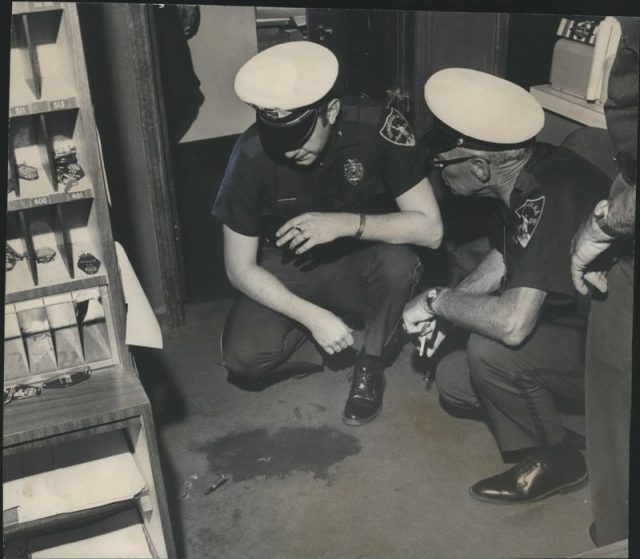
By Greg Garrison | ggarrison@al.com
This is another installment in Birmingham Times/AL.com joint series “Beyond the Violence: what can be done to address Birmingham’s rising homicide rate.” Sign up for the newsletter here.
A new city built on coal and iron ore mining, steel mills and railroads, Birmingham was violent from its beginnings in 1871, six years after the end of the Civil War.
The weapons of choice in the city’s early days were guns, knives, rope, dynamite – or whatever was handy.
In 1887, Dick Mitchell insulted George Pruit, who repaid the insult with a deadly blow from an iron poker to the head.
Three years before, Leon Houston, a 20-year-old Black man accused of rape, was broken out of jail by a white mob and hanged from a tree in what is now Linn Park, the first of about 30 lynchings in Birmingham documented by the Equal Justice Initiative. “Gentlemen, before God, I didn’t do it,” Houston said before he was hanged. “Jesus, take me home.”
It was the South, but it felt like the Wild West.
“In the 1880s, Birmingham shares more in common with Tombstone, Arizona, than the Old South,” said Jonathan Bass, professor of history at Samford University.
That violent streak extended from the 1880s into the 1980s, fueled by drug wars in the streets, and has again reached a fever pitch with young men gunning down other men with handguns.
“Birmingham had a reputation as one of the most violent cities not just in the South, but in the country,” said law professor Margaret Burnham, author of “By Hands Now Known: Jim Crow’s Legal Executioners,” and director of Northeastern University’s Civil Rights and Restorative Justice Project. “It has a history of industrial violence as well as racial violence. Obviously, there’s a relationship. It’s a dry forest. If you throw a match in there, you’re going to get a fire.”
Confederate soldiers who fought in the Civil War came to work in Birmingham’s mines and mills bitter at losing and sharpened to violent edges by conflict, said Kathryn Morgan, associate professor of criminal justice and director of African American Studies at UAB. “When young men came back from Civil War, they were addicted to guns and alcohol, and had an attitude of no duty to retreat; stand your ground,” said Morgan.
“The Civil War had returned the South to a frontier environment,” Bass said. “When Birmingham was founded as a new city, outside the Black Belt, there were no huge slave plantations like in the Black Belt.”
Race And Industrialization
The industrialization brought jobs and attracted thousands of Black men from the rural South and white immigrants from Europe who came to find work. They found jobs in a melting pot of violent confrontation.
“They are coming together rapidly, trying to find work, trying to find living arrangements against a backdrop of white supremacy, racism and honor culture,” said Brandon Jett, author of “Race, Crime and Policing in the Jim Crow South,” and professor of history at Florida Southwestern State College. “There was drinking, gambling and altercations.”
The problems in Birmingham are intertwined with race and industrialization.
“It’s dangerous work, hard work, dirty work; it’s also segregated work,” Jett said.
Guns, knives, and dynamite, which miners were expert in using, proliferated in acts of violence.
“Even in the 1930s, people were using dynamite,” in criminal attacks, Jett said.
Birmingham mixed an undercurrent of racial conflict with a Wild West ethos.
“You are entering the 20th Century with a lot of pistol-packing people in Birmingham,” Bass said. “Violence, especially racial violence, is steeped in the culture.”
Simple arguments and the stresses of life often turned fatal.
“There’s saloons, whorehouses, daily gunfights in the streets, migrants, rural Blacks, rural whites, immigrants, all coming together,” Bass said. “It’s based on industry, steel, iron, and coal mines, none of the things that were prominent before the Civil War. That established the pattern of drinking, fighting and murder, with homicide rates that were extremely high.”
The murder tally in Birmingham increased from 133 in 1913 to 137 in 1924 and a record 148 in 1933.
During the 1920s and 1930s, Birmingham vied for the title of most violent city in America, along with Memphis and Atlanta. Little has changed. In 1991, Birmingham had 141 homicides; in 2021, there were 132.
Through most of its history, the majority of the homicides in Birmingham have been Black male victims, killed by other Black males, against a backdrop of malevolent police and courts.
“Criminal statistics raise the whole question as to how far Black and white malefactors are subjected to different standards of justice,” the prominent Black sociologist and author W.E.B. DuBois wrote in 1897.
Violence in Black Communities
In 1932, Birmingham-Southern College Professor Kenneth E. Barnhart published a study on Black crime and concluded that police brutality, lack of access to education, and distrust of the justice system encouraged violence in Black communities.
“If illiteracy, police brutality, and the perversion of justice are factors in the Negro’s high homicide rate, the responsibility lies at the door of those communities which deny him the protection of the courts, adequate public schools, and a chance to live in decent surroundings,” wrote Barnhart, who was fired from Birmingham-Southern College for blaming the white community for Black violence.
“In the 1920s, Birmingham had one of the highest populations of African-Americans in the country for a city of its size,” Bass said. “That bothered white leaders. The segregation ordinances happened around that time. Another thing that contributes to Black-on-Black crime is a large population of large Black enclaves. The population density was much higher. Tensions can rise quicker when people are crammed together.”
One aspect of the Old South that came to industrial Birmingham was an honor code practiced by plantation owners who meted out their own justice based on what they perceived as violations of honor, Bass said.
“African-Americans learned from white slaveholders that sense of honor culture that carries over into the 1870s, 1880s, and 1890s,” Bass said.
White Birmingham police officers were often content to let violence play out in the Black community with minimal consequences and little interest in bringing justice to killers.
Black communities were often put in the position of having to enforce their own justice.
“Black on white crime is going to be reported,” he said. “White on Black crime might be. You don’t see a tremendous amount of humanitarian concern about Black-on-Black crime from the white community.”
That carried into the court system when all-white juries had the final say.
“Black on white crime is punished the most,” Bass said. “Black on black crime is punished the least.”
Police officers of the early 1900s in Birmingham had little or no formal training and were often brutal themselves.
“They’re extremely violent,” Bass said. “You’ve got ill-tempered, poorly trained police.”
Coal mining company security officers often did battle with unionizing workers, with dynamite and guns as weapons.
Even after the New Deal, when federal programs helped build housing for middle-class white families, Black families continued to live in impoverished and substandard housing, Bass said.
“A majority of New Deal housing was built for whites,” he said. “The type of housing that would have been available for the poor and working classes was these simple shotgun shacks with no plumbing, built up next to each other, large families living in three rooms, poor and working classes. That just contributes to the tensions that are going on. People are just crammed on top of each other, with no hope of escaping the airtight cage of poverty.”
Reluctant For Police Help
From the city’s beginnings, the Black community was reluctant to turn to police for help, knowing that police officers often employed methods as violent as the criminals.
“Birmingham has always been a violent place,” said Jim Baggett, archivist for the Birmingham Public Library. “From 1939-72, Birmingham police kept a set of 3×5 index cards of police shootings. There’s 109, which is probably not all.”
Barnhart in 1932 pointed out that 18 Black men were shot by police in Birmingham in 1930.
“Why is the rate of homicide among Negroes so high?” Barnhart wrote in 1932. “Apparently one reason is because so many Negroes are shot by policemen for ‘resisting arrest.’”
“No Way To Protect Yourself”
An AL.com study published in 2020 documented more than 500 people killed by police in Jefferson County from 1909-2020, including cases inside and outside of Birmingham city limits. More than 80 percent of those killed were Black. Such cases were typically classified as justifiable.
The violence and sometimes just indifference of an all-white police force through most of the city’s history left Black neighborhoods at risk and subject to vigilante violence.
“If you have a situation where you’re depriving people of democratic participation, they’re being miseducated, they’re subjected to rigid Jim Crow laws, there’s no way you can protect yourself,” Burnham said.
The patterns of substandard housing and poor-quality education continue today and contribute to the ongoing problem with gun violence in the city, said Morgan.
The litany of programs that have been tried over the decades have seemed to have negligible effect, Morgan said. Prayer walks through neighborhoods did not deter street violence.
Birmingham Mayor Randall Woodfin, whose older brother Ralph Woodfin was killed in 2012 in the now-demolished Southtown public housing community, has focused on education as a major initiative to combat violence, offering programs such as finance workshops for students, and college scholarships to graduates of the city schools through the Birmingham Promise.
He has emphasized that the people he talks to do not want fewer police officers or less law enforcement, simply better police officers enforcing the law fairly and keeping communities safe.
“We can keep looking at the past, and hope it helps with the future,” said UAB’s Morgan. “We need to study the relationship between homicides and violent crime and the decline of institutions, such as family, church, education, and religion. There are a lot of broken families, single mothers who have to work, and a lack of supervision of youth.”
Those who become killers do so because of a lack of hope, Morgan said. “They’re not participants in the American dream.”
Previous installments of the series:
Retired Birmingham Police Weigh In on City’s Growing Homicides | The Birmingham Times
John Archibald: Ignoring Murders of Black Males Won’t Make it Disappear | The Birmingham Times
Why Some Birmingham Residents Call Felicia Mearon Before They Call The Police | The Birmingham Times
Some Birmingham City Councilors Not Immune to Gun Violence | The Birmingham Times




